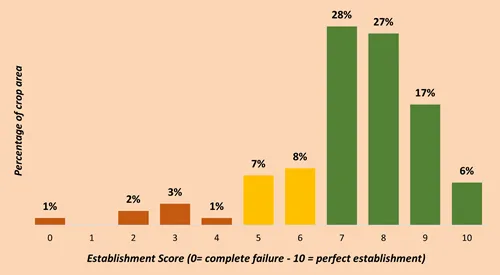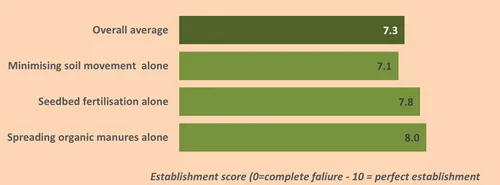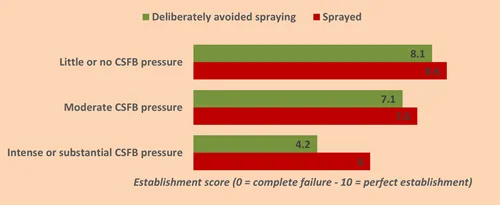
Despite a bone-dry August, later sowing than many planned and the highest levels of flea beetle pressure since 2019, British winter oilseed rape establishment this season has been remarkably good, according to the fourth year of Dekalb national grower polling
Author
| 1st January 2023Good Establishment Means Substantially Increased 2023 OSR Crop
Winter Oilseed Rape Establishment
Despite a bone-dry August, later sowing than many planned and the highest levels of flea beetle pressure since 2019, British winter oilseed rape establishment this season has been remarkably good, according to the fourth year of Dekalb national grower polling
This and the marked increase in plantings confirmed by the late October survey suggests the area of crop coming into next spring is set to be a good 10% up on 2022.
Reports from over 290 growers responsible for more than 30,000ha of 2022 plantings well-spread across the main oilseed rape growing areas of the country, show the vast majority of this year’s crop going into the winter in particularly good condition.
Almost 80% of plantings were, indeed, rated at 7.0 or more on the 0-10 scale (where 0 = complete failure and 10 = perfect establishment) with just 7% rated less than 5.0 (Figure 1).
“Barring major winter or early spring issues, these findings point to an overall crop survival to flowering similar to the past two years at around 90% of plantings,” says Bayer seed campaign manager and poll co-ordinator, Lizzie Carr-Archer.
“This is a vast improvement on the 67% survival to spring we recorded in the last particularly challenging establishment season of 2019/20. And it’s certainly not what large numbers of growers were expecting as recently as September.
With almost two thirds of respondents reporting very or fairly dry conditions at sowing and only just over a third considering them at least reasonable, this year’s poll shows moisture levels at sowing were actually worse than 2019.
Together with sowing delays prompted by the very dry conditions, this left many crops particularly open to the normal late August/early September cabbage stem flea beetle challenge.
While noticeably higher than the past two years, however, overall CSFB pressure proved to be well below the level of 2019, with only just over 20% of growers reporting substantial and intense challenges from the pest compared to more than 50% three seasons ago (Figure 2).
This and the fact that over 80% of growers reported receiving enough rainfall between sowing and late-October almost certainly accounts for the very much better position of the current crop going into winter.
“As ever, our study shows considerable differences between the regions in CSFB pressures and moisture conditions both at and after sowing,” Ms Carr-Archer notes. “Even those areas faring worst in terms of pest pressure and dryness, though, have generally better average establishment scores than 2019.
“Not surprisingly perhaps, the very much drier August led to a clear reversal of the trend to earlier drilling we’ve been recording over the past three seasons, with only around 40% of crops being sown before August 20th compared over 50% in 2021 (Figure 3).
“Unlike recent years too, it also meant that earlier sown crops didn’t necessarily establish better than those going in at a more traditional late-August timing, despite what continued to be higher CSFB pressures at this time. This reinforces the fundamental importance of the balance between pest pressure and moisture conditions in determining OSR establishment.
“Our latest data show CSFB pressure continues to have a greater impact on establishment than soil moisture,” she points out. “Crucially too, they underline that the real clincher in moisture terms is the amount of rainfall received after sowing rather than conditions at drilling. Indeed, the difference in average establishment score between the extremes here was far and away greater than between the extremes of moisture at sowing (Figure 4).”
With drilling conditions so dry, it is not surprising that this year’s poll shows few, if any, overall differences in establishment success between different variety types, establishment regimes or establishment management techniques.
Despite coming under greater CSFB pressure than pure lines (by virtue of being sown rather later on average) however, hybrids showed their value by establishing every bit as well.
There is a suggestion that subsoiler seeding was more successful than direct drilling, in particular. Once the fact that fewer direct drillers employed an insecticide at establishment is taken into consideration, though, any real difference here is questionable.
While no management technique showed any marked establishment score difference from the average either, those spreading organic manures reported the greatest success for the second year in a row.
When employed in the absence of any other main technique, spreading organic manures and seedbed fertilisation stood out as the only techniques giving noticeably higher establishment scores (Figure 5).
“This season’s poll gives particular confidence to those not letting the very dry early autumn put them off sticking with or increasing their winter OSR growing for 2023,” she concludes.
“There’s a lot of water to go under the bridge yet, of course. Having said that, the critical importance of establishment quality to crop performance and the extent to which both good crop establishment and later sowing are known to reduce the impact of CSFB larvae leaves us quietly confident of a substantial year-on-year increase in the crop going to harvest.
“After all, even in the particularly damaging CSFB season of 2019/20 growers only recorded an average crop loss of around 6% between early spring and harvest.”
Insecticide Spraying Changes
Unsurprisingly, greater CSFB pressure meant a higher proportion of growers spraying insecticide at establishment this season – 54% compared to 45% in 2021.
Encouragingly, though, this did not lead to a decline in the proportion of those deliberately avoiding spraying to encourage predators. If anything, indeed, this increased slightly – from 33% last season to 36%.
“Direct drillers are clearly leading the way here,” Ms Carr-Archer observes. “Amost half (48%) are now avoiding insecticide spraying at establishment and only 44% actually used a spray this season. This may reflect a more ‘conservation-focussed’ approach on the one hand and less need as a result of better conditions for crop establishment on the other.
“Those avoiding spraying did experience slightly less good establishment than the rest. So, insecticide use is clearly still having a positive effect for many; especially where CSFB pressures are higher (Figure 6).
“Even so, two thirds of growers overall and more than three quarters of mainstream hybrid growers deliberately not spraying recorded establishment scores of 7 or more. What’s more, greater predation may mean they gain from lower levels of larval damage.”
Figure 1: OSR Establishment 2022/23

Source: Dekalb National OSR Establishment Poll 2022, Bayer
Figure 2: CSFB Pressure at Establishment (2019 - 2022)

Source: Dekalb National OSR Studies 2019 to 2022, Bayer
Figure 3: Sowing Date Distribution (2019 - 2022)

Source: Dekalb National OSR Studies 2019 to 2022, Bayer
Figure 4: Establishment Score Differences between Extremes of Conditions

Source: Dekalb National OSR Establishment Poll 2022, Bayer
Figure 5: Establishment Score by Individual Management Technique (2022)

Source: Dekalb National OSR Establishment Poll 2022, Bayer
Figure 6: Establishment Score by CSFB Pressure and Insecticide Use (2022)

Source: Dekalb National OSR Establishment Poll 2022, Bayer